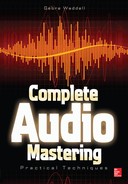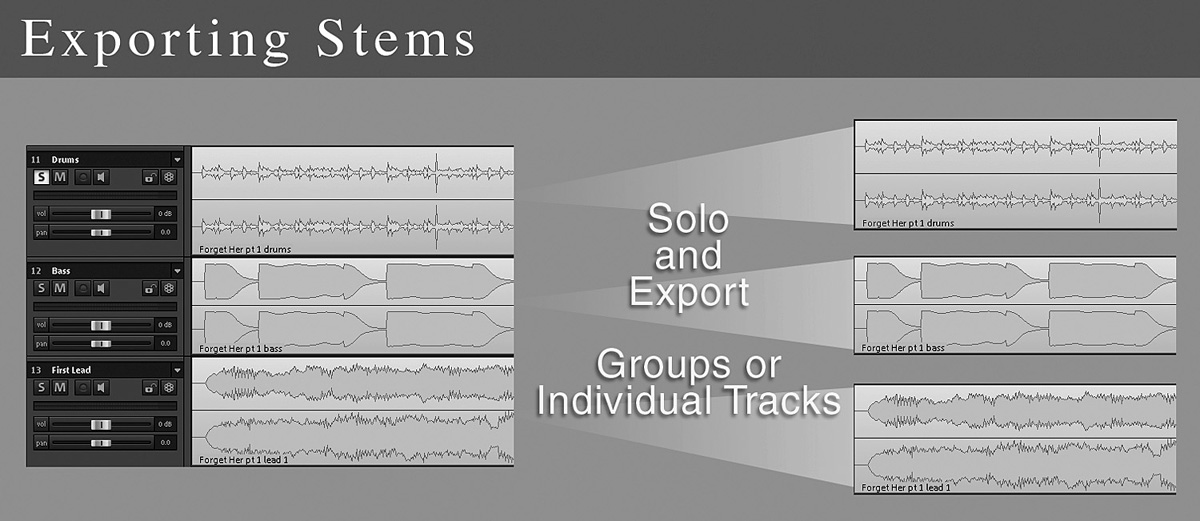CHAPTER 3
Preparing a Mix for Professional Mastering
Okay, so the mixes are finished and seem ready for mastering. There may be a few things you can do to make sure that they reach their full potential. In this chapter you will find out about some of the preparation professionals do to get the best out of the mastering process.
Maximum Peaks at –3 dB
Providing mixes for mastering that peak at a maximum of –3 dBFS (decibels relative to full scale) has become somewhat of a standard practice. To accomplish this, the mixing engineer can adjust their master fader during mixing until the highest peak shows on a digital peak meter at –3 dBFS. For the most part, this is a preventative measure. It provides a comfortable margin to ensure that there is no clipping. If 32-bit float resolution is used and is provided to the mastering studio, overloads are not possible. Even so, the –3-dBFS level is still usually observed.
NOTE FS (full scale) is added after dB to indicate a digital measurement of decibels because there are many types of decibel units of measure. While working in a DAW, virtually every dB abbreviation you see is actually dBFS. Another commonly discussed decibel type is dBSPL, which indicates a measurement of the sound pressure level using a microphone in the real world. For a comprehensive list, see Appendix A.
Mixing into a Limiter
Some mixing engineers mix with a transparent limiter on the master bus (such as Voxengo Elephant, Slate Digital’s FG-X, or Ozone’s IRC III). The master bus (also called the mixbus) is a channel in the DAW through which the entire mix is routed before it is heard or exported to a file. Adding a limiter to the master bus gives a sense of how the mix may respond to mastering. Master bus limiters also can be used to make more accurate reference comparisons between mixes and commercially released masters. The limiter is removed or bypassed before submitting the mix for mastering or somehow an alternate mix is submitted for mastering without the limiter.
Requesting the Removal of Mixbus Processing
Whereas some mastering studios request that all mixbus equalizer/compression processing be removed before mastering, it is not necessarily a good standard practice. The reasoning behind the idea is that novice engineers can harm the potential of their recordings by processing in ways that cannot be undone. However, experienced engineers who mix into a compressor or equalizer as part of their approach are actually tailoring the mix to its sound and would not be served by removing it.
Multiple Mono versus Stereo Interleaved
Multiple mono refers to a stereo recording saved as two recordings, one of the left channel and one of the right channel, each in separate audio files. The term stereo interleaved means that both channels are combined into a single stereo audio file. Opinions vary about which is better. A few engineers are sure there is an audible difference and prefer multiple mono. By far the most popular belief is that there is no difference, and stereo interleaved mixes are preferred.
Selecting Stem Mastering
Stem mastering is mastering performed from submixes called stems. When all the stems are played simultaneously (e.g., drums, guitars, vocals, and bass), they make up the entire mix. This process is shown in Figure 3-1. When stems are provided, the mastering engineer has more control over the mix. Stem mastering is typically used for situations where productions have significant problems that are unable to be addressed in mixing or by conventional mastering. It also can be useful when a project needs cohesiveness that may not be possible due to various project restrictions. Stems may be required for some television/film/broadcast applications and are sometimes specified in recording contracts. Stem mastering requires extra time and a different way of working, and for those reasons, it is more costly. The vast majority of mastering engineers prefer to work from stems only when clients demand it. Very few mastering engineers prefer stems and have developed approaches for working with them.
FIGURE 3-1 Solo an individual track or a group of tracks, and then export to create a stem. When all the stems of a mix are combined, they represent the entire mix.
Allowing Time for Mastering
Deadlines always should be clearly communicated to the mastering studio. Mastering can take time for developing tailored processing. Because of this, plenty of time should be allotted in the production schedule to permit the highest-quality mastering. Normally, two weeks is very safe, although under ideal conditions professional mastering sessions may take only a few hours.
Sample Rate
Mixes are often delivered for mastering at 44.1k; 48k; 88.2k; 96k; or 192k sample rates. In the digital audio world, samples are data points that make up the audio waveform and ultimately represent speaker movement. The term sample rate refers to the number of samples per second of a digital recording. There is some controversy surrounding the benefit of high sample rates. Critics quote the Nyquist-Shannon sampling theorem, which describes the relationship between sample rates and audio frequencies. To summarize the theorem: When the sample rate is divided in half (e.g., 44.1k), the result is the highest audio frequency that can be reproduced at that sample rate (e.g., 22.05 kHz).
Human hearing is thought not to extend beyond 22.05 kHz, so a sample rate of 44.1k is sufficient for the full range. There are scientists who have set up experiments that show that you may be able to sense frequencies far beyond this range. There are others who believe that the way the experiments were conducted render them invalid and who generally disagree with the proposition. Critics believe that when frequencies over 22 kHz are added to a recording, it leads to distortions within the audible range on most playback systems. These distortions are then interpreted as an improvement to the highest frequencies. They suggest that distortion can be added between 16 and 22 kHz to get the same or a similar effect. While the critics’ argument about playback is not without merit, it may not take into account the digital-processing benefits within the audible range that can be experienced at higher sample rates during processing.
Digital processing can produce better results at higher sample rates. Today’s digital processors often have internal upsampling features built in, at least somewhat negating the benefit of working with high-sample-rate recordings.
There are some advanced sample rate conversion algorithms that greatly reduce conversion problems to a possibly inaudible level.
Mastering to Tape
Some of the best mixes in the world are bounced to tape, and the mastering studio is provided with tape reels. Many legendary engineers still think that this is best and have their own favorite tape machines and calibration settings.
Bass and “Air”
The best mix is one with a perfect balance between the frequency ranges. Sometimes acoustics or monitoring do not permit an ideal balance, especially in home or project studios. When the ideal balance is not possible, most mastering engineers would agree that it is best to err on the side of too little bass and too little “air” (very high frequencies) in preparation for mastering.
Mix Problems
Mastering studios often have some method of providing amateur clients with information to improve their recordings outside the possibilities of mastering. This might be as simple as a list of resources for recommending to clients or as extensive as creating unique resources. Mastering engineers must maintain knowledge of audio concepts in order to provide assistance to mixing engineers. Most mastering engineers agree that technical mixing issues heard by the mastering engineer should be discussed with the client. Also, many mastering engineers think that it’s best not to provide feedback except strictly on technical issues unless their opinion is sought.
Highly revered mastering engineers and studios are sometimes thought to achieve their sound only because they receive stellar mixes. This is untrue—the most talented mastering engineers usually can contribute something great even with less than ideal mixes and receive plenty of them.

